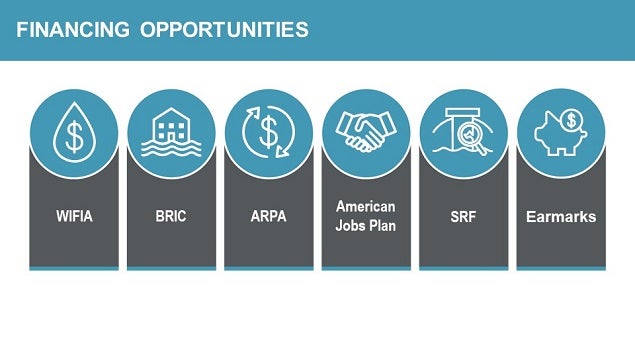
What EPA’s PFAS LHAs Mean for Water Utilities
Four PFAS Make Headlines
On June 15, the U.S. Environmental Protection Agency published lifetime health advisories for four per- and polyfluoroalkyl substances (PFAS), which included PFOA, PFOS, GenX and PFBS.
The updated LHAs are as follows, in parts per trillion (ppt):
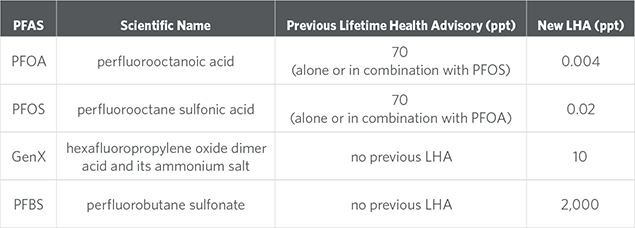
What Are PFAS?
PFAS are a group of human-made chemicals that have been produced since the 1940s that are used in industrial and consumer products for their flame retardant, non-stick and water-resistant qualities. The unique properties and extended use of PFAS have led to their ubiquitous presence in the environment. They are found across the hydrologic cycle throughout the world.
Recent focus has been placed on PFAS, as studies have shown that exposure to some of these compounds at certain levels may adversely impact human health. EPA’s PFAS Strategic Roadmap (pdf) outlines EPA’s multi-sector approach toward managing PFAS contamination. Among other actions described in the Roadmap, the EPA committed to publish drinking water health advisories for PFAS in Spring 2022. With the recent announcement, this commitment has been met.
What Is an LHA?
Lifetime health advisories (LHAs) are non-enforceable and non-regulatory contaminant levels at which no adverse health effects are expected over a lifetime of drinking water exposure. These advisories provide technical information that supports the efforts of regulators and water system managers as they continue protecting the public’s health.
Even though these LHAs are non-enforceable, they pave the road for the EPA to establish National Primary Drinking Water Regulations (NPDWRs) for these compounds. EPA’s Roadmap sets a timeline to establish draft NPDWRs for PFOA and PFOS by the end of Fall 2022 and final regulations by Fall 2023.
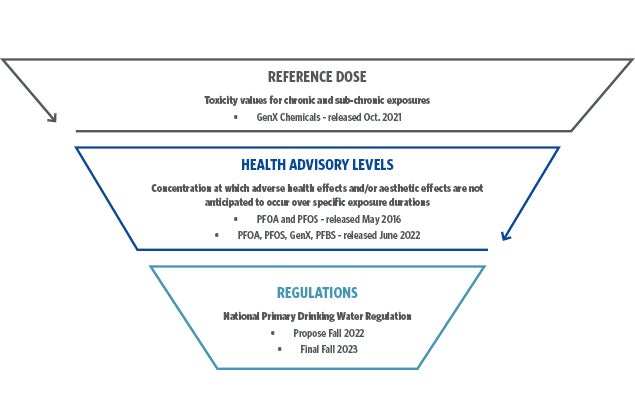
Also, it is important to note that the LHAs for PFOA and PFOS are well below current analytical detection limits, as current EPA standard methods target minimum report levels for both compounds at 4 ppt. Therefore, EPA is communicating that “the lower the level of PFOA and PFOS, the lower the risk” to encourage drinking water systems to maximize removal to the lowest levels feasible.
What Does This Mean for Water Utilities?
Considering the LHA levels, utilities should begin planning for a future regulation, including a MCL, even though any enforceable limits will likely be greater than the LHAs for practical reasons. Utilities that get a head start on planning will have the best opportunity to stay in front of customer perceptions, budgetary needs, available funding and eventual compliance.
There will be no one-size-fits-all response to the future regulations, as each water source, utility and community are different. Some of our clients have started to respond by:
- Studying PFAS in their source waters
- Investigating where these compounds originate
- Implementing source water protection best practices
- Validating treatment technologies through bench and pilot-scale testing
- Evaluating options for full-scale treatment implementation
- Establishing a strategic communication plan
Even without an established NDPWR today, the publication of new LHAs serves as a call to action for utilities to assess and implement their program needs ahead of EPA’s aggressive schedule.
Plan Your Path to PFAS Compliance
The following list provides an overview of common questions and our recommended next steps to help utilities evaluate their PFAS issues and response plan.
Are PFAS present in your water system?
Establishing a sampling plan is the first step to determine the occurrence, type and level of PFAS in source and finished water supplies. Getting ahead on the monitoring requirements for the Fifth Unregulated Contaminant Monitoring Rule (UCMR 5) today, allows utilities more time to plan communication efforts, develop mitigation strategies and evaluate available funding options, if needed. UCMR 5 testing is scheduled to be completed between 2023 and 2025.
Many utilities have previously tested for PFAS several years ago, as part of UCMR 3. UCMR 3 included testing for six PFAS, including PFOA, PFOS and PFBS. UCMR 5 builds upon this past effort to monitor a total of 29 PFAS, using revised methods with significantly lower minimum reporting levels. Utilities that had “no” PFAS previously may discover their presence due to the increased number of PFAS tested and improved analytical techniques. The table below summarizes the differences between UCMR 3, UCMR 5 and the LHAs for PFOS, PFOA and PFBS.

We support our clients in their efforts to establish sampling plans, coordinate analytical lab shipments, develop protocols that minimize sample contamination, and understand the significance of PFAS analytical results. You will have confidence in decision making and public communications through a well-organized and executed sampling plan.
How do you find out where PFAS is coming from?
Assessing fate and transport of PFAS through watersheds and groundwater supplies using dynamic models is a powerful tool for utilities to understand where PFAS enters their water supply. Traditional groundwater and surface water fate and transport models coupled with PFAS species fingerprinting provide insight into source identification and treatment needs. Fate and transport modeling can be used to evaluate well decommissioning or well blending scenarios. Surface water modeling can provide concentration and travel time estimates for utility water supply intakes and inform treatment and operational strategies. Our PFAS experts and modelers can help utilities prepare these dynamic models to help devise strategies for addressing PFAS contamination. We believe optimized solutions can be achieved with a thorough understanding of the fate and transport of PFAS in source water.
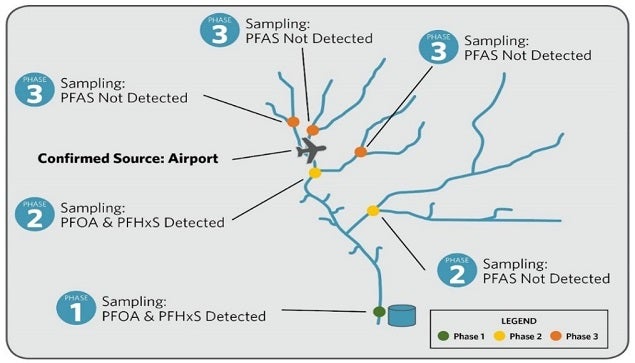
How do you communicate to customers about the risks of PFAS?
Establishing a strategic communication plan to help utilities protect their customers — and maintain their trust — is imperative as sampling results come in.
In the face of a pervasive group of contaminants, confusing health risk information and potentially expensive mitigation, utilities will benefit by establishing themselves as reliable, caring guardians of public health up front or risk misunderstanding and opposition when they need community cooperation to act. We can work as an extension of in-house communication teams or on utilities’ behalf to craft and execute a data-driven communications strategy. A tailored approach can empower your workforce, create educated champions in the community and reach the broader customer base through the channels it already uses. Effective communication builds trust, and trust makes it easier to operate across the board. You will gain support and confidence of the public from a factual and appropriate strategic communications program.

What treatment evaluations are needed to achieve finished water PFAS goals?
Removing PFAS at water treatment facilities represents the last line of defense for PFAS mitigation. Whether groundwater or surface water, initial bench and pilot testing is recommended due to the variability in the source water quality, PFAS speciation and their respective concentrations. Initial testing provides key information on relative process performance, establishes basis of design parameters and generates important operational data that informs life cycle cost estimates.
We have helped utilities evaluate numerous proven technologies for PFAS removal, including ion exchange (IX), granular activated carbon (GAC) adsorption, nanofiltration (NF) and reverse osmosis (RO). Bench scale testing, such as Rapid Small Scale Column Tests (RSSCT), can be used to quickly evaluate the relative performance of various different GAC media and IX resins. Pilot testing provides additional data reliability, optimization opportunities and directly scalable data for full scale design and operational criteria. Unlike GAC and IX, technologies like NF and RO produce a PFAS-laden concentrate stream that must be further treated before disposal or discharge. Both bench and pilot testing can provide valuable information on concentrate characterization and treatment requirements. Our team can support the development and implementation of a customized PFAS bench and pilot testing program that informs your data-driven decisions to protect public health, achieve regulatory compliance and implement cost-effective solutions.

When should a water utility implement PFAS treatment?
This is perhaps the most complex question in the current PFAS regulatory environment, as the LHAs are non-enforceable but still carry public health and perception significance. A prudent approach would be to plan on “triggers” for treatment implementation that consider the occurrence of PFAS within a system, the regulatory schedule laid out in the EPA’s Roadmap and any current or pending state regulations. A thorough characterization of PFAS speciation will further clarify treatment requirements. We are working with utilities nationwide to develop implementation plans and timelines for action and trigger points based on individual community and utility needs. Variables include proximity to impacted waterbodies, the state regulatory environment, the federal regulatory schedule, access to funding and customer expectations.
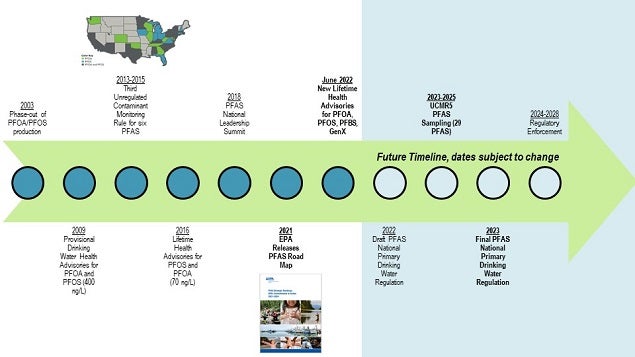
How will utilities pay for PFAS treatment?
Investments that address drinking water quality needs are an eligible expense under the existing Drinking Water State Revolving Funds (SRF), but new funding programs to address PFAS and other emerging contaminant pollution are a focus at the state and national levels. The Bipartisan Infrastructure Law alone provides $10 billion in new funding opportunities providing drinking water and wastewater systems with an unprecedented opportunity to apply for grants, principal forgiveness, low-interest loans or a combination thereof to address PFAS challenges. These funds are allocated to the states and then awarded to grantees that meet specified requirements. We understand these funding programs, having worked in both the public and the private sector, implementing them and securing funding for small, medium and large communities. We can assist with understanding your state’s funding, processes and program implementation to maximize your funding opportunities. You can minimize rate payer impacts today by capitalizing on currently available federal resources.
